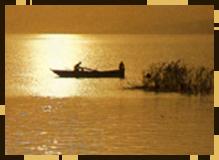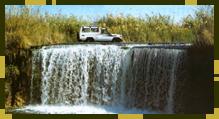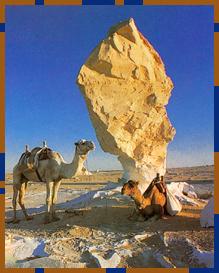Oases
The
archaeological site of 'Ayn Asil, in the Dakhla Oasis, proves
that at least Dakhla was considered of a certain importance
during the Old Kingdom. Little is known for the moment about
a contemporary occupation of the other oases, the way the
ancient Egyptians named these areas in the Western Desert
is still unclear. Herodotus, the Greek traveller and historian,
spent a few months in Egypt in the V century BC and visited
Siwa, seat of the famous Oracle of Amun which had achieved
a considerable importance throughout the Greek world. After
the Roman conquest, all the oases seemed to have been included
in a vast project of cultivation, and fortification whenever
they happened to mark the southern border of the Empire. It
was in the Middle Ages that Arab travellers, across the Western
Desert, introduced the idea of buried treasures and actually
started the mania of treasure hunting, which has never really
faded away.
 |
The
modern scientific exploration of the Western Desert started
towards the end of the XIX century thanks to German and British
scholars and geographers, followed by the first Egyptian explorers.
Among others, it was Georg Schweinfurth, who founded the Royal
geographical Society of Egypt; Gerhard Rohlfs, who organised
the first interdisciplinary expedition in the Western Desert;
John Ball and Hugh Beadnell, who worked in the oases for the
Geological Survey of Egypt, Ahmed Hassanein, who made a remarkable
journey from the Mediterranean coast down to the Sudan, Prince
Kamal el-Din, who explored and mapped large sections of the
Western Desert, and Ahmed Fakhry, the first Egyptian Egyptologist
to visit and record the antiquities of the oases.
 |
Rohlfs,
travelling by camel, for the first time headed west to the
unknown Great Sand Sea, where his expedition had quite a hard
time. Saved by a miraculous rainfall, they named the spot
where they could refill their reserve of water "Regenfeld"
(lit. field of the rain) and left there a message in a bottle
marked by a cairn. Fifty years later, Prince Kamal el-Din
found the cairn and added another message, which is probably
still there waiting for a new expedition. Instead of using
camels, he travelled across the desert using Citroen caterpillars,
while the British traveller Ralph Bagnold opted for Ford cars
to explore the Great Sand Sea and the region south of Kharga.
|

|
Exploration
from the air was carried out by Ladislaus de Almasy and Robert
Clayton, who organised an expedition to the south-western
region of Gilf Kebir and Uweynat which then inspired the book
(and the movie) "The English Patient".
Modern
satellite images have filled the large blank sections that
were typical of the maps drawn by the early explorers, but
this does not mean that the desert has given up all its secrets
or that it has lost its fascination. Travelling by car in
the Western Desert is certainly easier now than a few decades
ago, when the oases were connected to the Valley and to one
another by desert tracks only. The tarred road between Cairo
and Baharia, for example, was built in the late '60s. The
oases are the focus of an ambitious project of land reclaimation,
and obviously the connections among them are an important
part of this plan. The New Valley is now linked to Cairo by
regular flights, and many of the desert roads are undergoing
significant works of improvement, including the construction
of resting places, petrol stations and emergency units at
regular intervals.
 |
Some
tourists go around in minibuses with organised tours, others
travel in 4x4s on their own. For long and difficult tours
in harsh regions of the desert, it is possible to join an
organised tours that includes everything, from food to tents,
from 4x4 to guides. Otherwise, military permission, good cars,
expert drivers and a certain experience of the desert and
its potential problems (including mine fields in some areas)
are mandatory. In general, for less demanding tours, a group
of two to three 4x4 (never go off road on difficult tracks
with one car only!) and a little experience of desert driving
is enough to visit many of the places which will be described
below. It is important to bear in mind that all the archaeological
sites must be visited with the permission of the local Inspectorates,
who may also provide local guides to reach the most hidden
or complicated destinations. A visit to the local authorities
will also clarify whether a special permission is needed to
visit certain areas. The majority of the desert roads are
in fact controlled by military check points, which from time
to time may require a written document to allow passage.
(Corinna
Rossi)
|
|